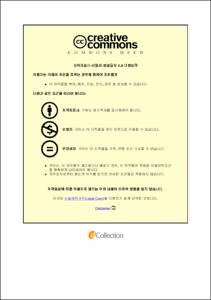Self-Healable, Stretchable, and Conductive PVA/PEDOT: PSS Hydrogel for Wearable Motion Sensor
- Alternative Title
- 웨어러블 모션센서용자가치유성, 신축성 및 전도성 PVA/PEDOT:PSS 하이드로겔
- Abstract
- Wearable electronic devices such as electronic skin, electrical sensors, and health equipment have received incredible attention. As a flexible and stretchable polymer with extensive applications, PVA hydrogel has gained significant attention. This water-soluble polymer has many hydroxyls that are easily induced to form many hydroxyl bonds. Within that ability, PVA has the potential to prepare a self-healable hydrogel based on hydrogen bonding. To achieve the wearable device’s ability, we fabricate stretchable and conductive interpenetrating network (IPN) hydrogel composed of polyvinyl alcohol (PVA) in the presence of Glutaraldehyde and Hydrochloric acid as a cross-linker solution and poly (3,5-ethylene dioxythiophene): polystyrene sulfonate (PEDOT: PSS) as the conductive agent. The obtained healable PVA/PEDOT: PSS hydrogel is characterized by Raman, and TGA indicates the interaction between PVA, cross-linker, and PEDOT: PSS in it. We conduct the tensile test and sheet resistance measurement for self-healable properties. The hydrogel obtains excellent self-healable ability by showing could perform 157.32% at the break after healing for 2 hours. Meanwhile, for the electrical ability, we perform post-treatment using Sodium Chloride and check the sheet resistance during the stretch condition. The hydrogel showed stable resistivity with only an increase of 1.7-fold from the initial resistance. The feasibility and advantages of healable PVA/PEDOT: PSS hydrogel in detecting a physiological signal as a sensor are demonstrated. The fabricated hydrogel exhibits excellent results in detecting human motion, compression motion, and humidity of breathing. Besides that, the hydrogel being compatible with skin attachment, this healable hydrogel can maintain its mechanical robustness and has promising applications in wearable devices and sensors.
전자 피부, 전기 센서 및 건강 장비와 같은 웨어러블 전자 장치는 놀라운 주목을 받았습니다. 광범위하게 응용되는 유연하고 신축성 있는 폴리머로서 PVA 하이드로겔은 상당한 주목을 받았습니다. 이 수용성 고분자는 많은 수산기를 가지고 있어 쉽게 유도되어 많은 수산기 결합을 형성합니다. 그 능력 내에서 PVA는 수소 결합을 기반으로 하는 자가 치유 하이드로겔을 제조할 가능성이 있습니다. 웨어러블 장치의 기능을 달성하기 위해 가교제 용액으로 글루타르알데히드 및 염산과 폴리(3,5-에틸렌 디옥시티오펜)이 있는 상태에서 폴리비닐 알코올(PVA)로 구성된 신축성 및 전도성 상호 침투 네트워크(IPN) 하이드로겔을 제작합니다. 도전제로 폴리스티렌 설포네이트(PEDOT: PSS). 얻어진 치유 가능한 PVA/PEDOT:PSS 하이드로겔은 Raman을 특징으로 하며, TGA는 PVA, 가교제 및 PEDOT: PSS 간의 상호작용을 나타냅니다. 자가 치유 특성에 대한 인장 시험 및 시트 저항 측정을 수행합니다. 하이드로겔은 2시간 동안 치유 후 파단 시 157.32%를 수행할 수 있음을 보여줌으로써 우수한 자가 치유 능력을 얻습니다. 한편, 전기적 능력은 Sodium Chloride를 이용하여 후처리를 하고 신축 상태에서 면저항을 확인한다. 하이드로겔은 초기 저항보다 1.7배만 증가하여 안정적인 저항을 보였다. 치유 가능한 PVA/PEDOT: PSS 하이드로겔이 생리적 신호를 센서로 감지할 때의 가능성과 장점이 입증되었습니다. 제작된 하이드로겔은 사람의 움직임, 압박 움직임, 호흡의 습도를 감지하는 데 탁월한 결과를 보입니다. 그 외에도, 하이드로겔은 피부 부착과 호환되므로 이 치유 가능한 하이드로겔은 기계적 견고성을 유지할 수 있으며 웨어러블 장치 및 센서에 유망한 응용 분야를 가지고 있습니다
- Issued Date
- 2022
- Awarded Date
- 2022. 8
- Type
- Dissertation
- Publisher
- Pukyong National University
- Affiliation
- Pukyong National University, Graduate School
- Department
- 대학원 스마트그린기술융합공학과
- Advisor
- KimYonghyun
- Table Of Contents
- I. Introduction 1
II. Theoretical Basis 4
2.1 Wearable Device 4
2.2 Hydrogel as Wearable Device 5
2.3 Self-Healable Hydrogel 6
2.3.1 Non-covalent Interaction 7
2.3.2 Covalent Interaction 11
2.4 Conductive Hydrogel based on PEDOT:PSS 14
2.4.1 Interpenetrating Network (IPN) Hydrogel 16
2.5 PEDOT:PSS Based Sensor 17
2.5.1 Pressure Sensor 17
2.5.2 Strain Sensor 19
2.5.3 Humidity Sensor 20
III. Experimental Section 21
3.1 Materials 21
3.2 Preparation of PEDOT: PSS solution 22
3.3 Fabrication of PVA-PEDOT: PSS Self-Healable Hydrogel 22
3.4 Post-Treatment of The PVA-PEDOT:PSS Hydrogel 23
3.5 Characterization 23
IV. Results and Discussion 25
4.1 Optimizing PEDOT:PSS Composition 25
4.1.1 Tensile Test Result 25
4.1.2 Sheet Resistance and I-V Curve Result 27
4.2 Characterization of the Pure PVA and PVA/PEDOT:PSS Hydrogel 28
4.2.1 Raman Spectra and TGA Result 28
4.2.2 SEM Result 30
4.3 Self-Healable Hydrogel Properties 32
4.3.1 Tensile Test Result 32
4.3.2 Electrical Properties of the Self-Healable Hydrogel 34
4.4 Post Treatment for Improving Conductivity 36
4.4.1 Electrical Properties of Post-Treatment Hydrogel 36
4.4.2 Raman Spectra Result 37
4.4.3 SEM Result of Post-Treatment Hydrogel 40
4.5 Sensor Test Application 41
4.5.1 Gauge Factor and Compression Sensor 41
4.5.2 Motion Strain Sensor 43
4.5.3 Subtle Motion Sensor 44
4.5.4 Humidity Sensor 45
V. Conclusion 48
References 50
Acknowledgements 60
- Degree
- Master
- Appears in Collections:
- 대학원 > 스마트그린기술융합공학과
- Files in This Item:
-
-
Download
 PEDOT: PSS Hydrogel for Wearable Motion Sensor.pdf
기타 데이터 / 3.99 MB / Adobe PDF
PEDOT: PSS Hydrogel for Wearable Motion Sensor.pdf
기타 데이터 / 3.99 MB / Adobe PDF
-
Items in Repository are protected by copyright, with all rights reserved, unless otherwise indicated.